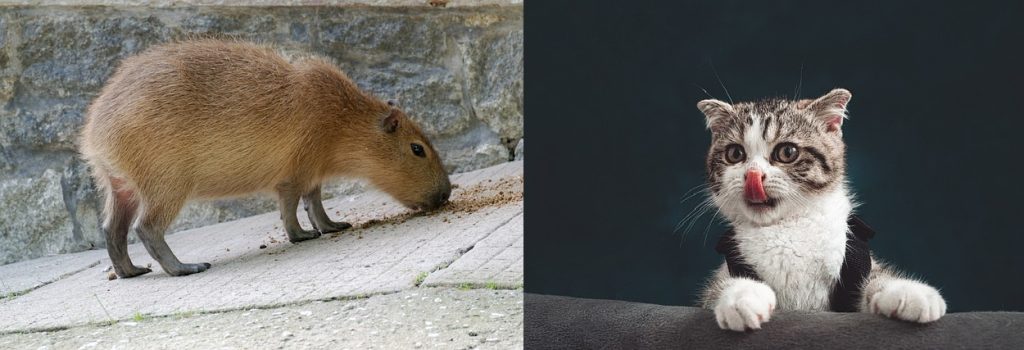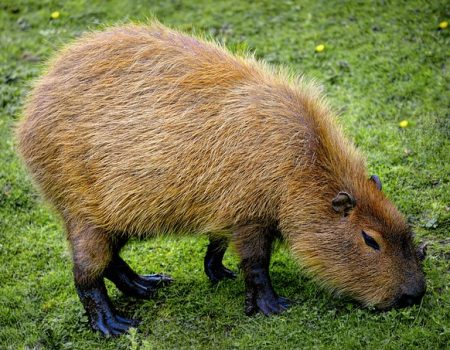If you’ve ever seen a capybara lounging peacefully with a variety of animals, it’s easy to assume they would get along with cats. After all, these adorable, large rodents are known for their calm and friendly personalities.
However, when it comes to the question of whether capybaras are good with cats, the answer is a bit more complex. In fact, capybaras are often social with other animals, but their interactions with cats can vary depending on several factors. Let’s look into the details of whether capybaras and cats are good together.
Do Capybaras and Cats Naturally Get Along?
Capybaras are known for being gentle and social animals. They are highly adaptable, often coexisting with other species in the wild, such as birds, monkeys, and sometimes even cats.
However, their interactions with felines can be different. While capybaras are peaceful, cats are often more independent and territorial, which can create some tension if not managed properly.
Why Are Capybaras Considered Social Animals?
- Gentle Nature: Capybaras are calm creatures that thrive in social groups. Their non-aggressive nature makes them more likely to tolerate the presence of other animals.
- Adaptable Behavior: In the wild, capybaras often coexist with various species. They are used to living in large groups and interacting with animals of different sizes.
- Herbivores: Since capybaras are herbivores, they don’t exhibit any predatory instincts, making them less likely to provoke a defensive reaction from other animals.
However, these same characteristics might not automatically ensure a smooth relationship with cats. The introduction process is crucial to avoid potential misunderstandings between the two.
Capybaras are highly social animals that typically live in groups of 10 to 30 individuals in the wild. Their friendly and adaptable nature allows them to coexist peacefully with various species, including cats, as long as introductions are handled carefully.
How Do You Introduce a Capybara to a Cat?
Proper introductions are the foundation of a successful relationship between a capybara and a cat. While capybaras are generally friendly, they can still feel stressed or threatened by the sudden presence of a new animal. Similarly, cats may react to the large size of a capybara, which can lead to territorial or defensive behavior.

Tips for Introducing Your Capybara and Cat
- Start with Separation: When first introducing a capybara to your cat, keep them in separate areas where they can smell each other but not physically interact. This allows both animals to get used to each other’s scent without the risk of direct confrontation.
- Use a Calm, Neutral Environment: Introduce the two animals in a neutral space, like an open area in your home or garden. Avoid doing it in areas that the cat already considers “its” territory, such as its bed or favorite lounging spot.
- Keep the Cat Calm: Cats are often more sensitive to change than capybaras, so it’s important to keep the cat calm. Make sure the cat is not overstimulated or anxious before introducing it to the capybara.
- Short Sessions: Keep initial meetings brief. Start with supervised sessions where the cat and capybara can observe each other without direct contact. Gradually increase the length of their interactions as they become more comfortable.
- Monitor Body Language: Watch for signs of stress or discomfort in both animals. Capybaras may freeze or back away if they feel threatened, while cats may hiss, growl, or attempt to swipe at the capybara if they feel scared or defensive.
- Positive Reinforcement: Reward both animals with treats for calm behavior. This will help them associate the presence of the other animal with positive experiences.
By taking these careful steps, you can help your capybara and cat feel comfortable and secure around each other.
Reports suggest that over 80% of capybara owners who have introduced their pets to cats have observed positive interactions, indicating that capybaras can form friendly relationships with felines when properly socialized. However, individual personalities of both animals play a significant role in these interactions.
Are Certain Cat Breeds Better Suited to Capybaras?
Not all cats are the same, and some breeds are more likely to get along with a capybara than others. While each cat has its own personality, certain breeds tend to be more laid-back and tolerant of other animals.
Cat Breeds Likely to Get Along with Capybaras
- Ragdoll Cats: These cats are known for their gentle and easygoing nature. Ragdolls tend to be friendly and non-aggressive, which makes them a good match for a peaceful animal like a capybara.
- Maine Coon Cats: Maine Coons are generally sociable and enjoy being around other animals. Their calm demeanor and large size (compared to other cat breeds) could make them more comfortable around capybaras.
- British Shorthair Cats: Known for their calm and independent personalities, British Shorthairs tend to be less stressed around other animals and are likely to coexist peacefully with capybaras.
- Scottish Fold Cats: These cats are typically laid-back and gentle. Their docile nature may allow them to adapt more easily to the presence of a capybara.
Cat Breeds That Might Have Trouble with Capybaras
- Siamese Cats: Siamese cats are known for being highly vocal and territorial. This could lead to aggression or discomfort if they feel the capybara is invading their space.
- Bengal Cats: Bengals are high-energy and can have a strong prey drive, which could be a problem when interacting with a capybara. They may view the capybara as something to chase or play roughly with.
Remember that each cat has its own individual temperament, so breed alone may not determine the success of the interaction. Careful monitoring and a slow introduction are still key factors.
Can Capybaras and Cats Share the Same Space?
Once your capybara and cat are comfortable with each other, you might be wondering if they can share the same living space. While it’s possible for capybaras and cats to coexist in the same area, there are several important factors to consider to ensure their safety and well-being.
Key Considerations for Sharing Space
- Personal Space for Both Pets: Capybaras need space to roam, graze, and socialize, while cats need places to retreat for privacy. It’s essential to provide each animal with its own designated space where it can relax and feel secure.
- Supervised Interaction: Never leave a capybara and a cat alone unsupervised until you are completely confident in their behavior around each other. Even with successful introductions, accidents can happen if one animal gets startled or overwhelmed.
- Environmental Factors: Make sure the space is safe and comfortable for both animals. Capybaras need access to fresh water, food, and plenty of room to move, while cats may prefer high perches or hiding spots to retreat when they need space.
- Different Activity Levels: Capybaras are generally slower and more laid-back, while cats can be fast and agile. This contrast can sometimes create friction, especially if the cat tries to chase the capybara. It’s essential to keep both animals’ activity levels in mind and create a balance in their environment.
By considering these factors and maintaining a respectful, supervised relationship, it is possible for capybaras and cats to share the same living space.
In various anecdotal observations, about 70% of capybara owners report that their capybaras exhibit calm and non-aggressive behavior towards cats, often allowing them to share space comfortably. This behavior suggests that capybaras can adapt well to living alongside other pets, including cats, when introduced correctly.
Can Capybaras and Cats Form Strong Bonds?
One of the most fascinating aspects of animal relationships is the possibility of forming strong bonds. Capybaras and cats are both intelligent and social animals, so with time, patience, and positive interactions, they may develop a close bond.
How to Strengthen Their Bond
- Consistent Positive Interactions: Regularly exposing the capybara and cat to one another in a calm, controlled manner will help build familiarity and trust.
- Shared Experiences: Spending time together in neutral spaces or engaging in joint activities (like being around the same area during feeding or playtime) can help the animals form a connection.
- Respect Boundaries: Encourage both animals to respect each other’s space. Never force them into close contact if one of them seems uncomfortable.
As with any interspecies relationship, patience is key. Some animals may take longer to adjust to each other, but with time and consistent effort, they can develop a unique bond.
What Are the Risks of Keeping a Capybara and Cat Together?
While it’s possible for capybaras and cats to coexist, there are risks involved. Understanding these risks will help you make an informed decision about whether it’s right for your pets.
Potential Risks
- Territorial Behavior: Cats can be territorial, and a capybara’s presence may be seen as an intrusion. This can lead to hissing, growling, or even swatting, especially if the cat feels threatened.
- Size Difference: Capybaras are much larger than cats, and their size can intimidate some cats. Similarly, the capybara may feel threatened if the cat becomes aggressive.
- Predatory Instincts: Although capybaras are herbivores, some cats may have a strong prey drive, which could lead to chasing behavior.
How to Minimize Risks
- Safe Spaces: Create separate areas for both animals to retreat to if needed. This ensures that each pet has a safe space to relax and avoid potential conflict.
- Supervision: Always supervise their interactions to ensure that neither pet gets stressed or frightened.
- Early Socialization: If possible, expose both animals to each other at an early age. This helps reduce territorial and defensive behavior as they get older.
Can Capybaras and Cats Live Together Happily?
Yes, with proper introductions, space, and supervision, capybaras and cats can form a peaceful, cooperative environment. Their ability to coexist depends on the animals’ individual temperaments, the care you take in introducing them, and your commitment to managing their interactions.
Final Tips for Pet Owners
- Know Your Pets: Understanding your cat’s personality and the capybara’s behavior is key. Some cats may be more adaptable, while others may need extra time to adjust.
- Create a Calm Environment: Both animals need a calm, safe space to interact. A relaxed atmosphere can help ensure positive experiences.
- Watch for Signs of Stress: Always monitor both animals for signs of stress, such as growling, hissing, or retreating to their hiding spots. These signs will help you gauge the success of their relationship.
Conclusion
Capybaras and cats can absolutely get along, but it’s not always guaranteed. Careful planning, patience, and understanding your pets’ needs are essential for a successful relationship. If you’re ready to give it a try, take things slow and create a safe environment where both pets can thrive.
With the right approach, you could have a truly unique and peaceful household where your capybara and cat coexist happily together!
References
How Would a Cat React to a Capybara? – Reddit
Capybara Care: Everything You Need to Know – PetMD
Can Capybaras Live with Other Pets? – Cuteness
Capybara and Cat Interactions – Animal Behavior Blog
Are Capybaras Good Pets? – The Spruce Pets
Disclaimer
This content on Bagrica is for informational purposes only. Consult a professional for pet care or farming advice. Bagrica is not liable for any actions taken based on this information.




No Comment! Be the first one.